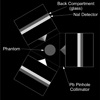Few-view single photon emission computed tomography (SPECT) reconstruction based on a blurred piecewise constant object model
- PMID: 23892823
- PMCID: PMC3844694
- DOI: 10.1088/0031-9155/58/16/5629
Few-view single photon emission computed tomography (SPECT) reconstruction based on a blurred piecewise constant object model
Abstract
A sparsity-exploiting algorithm intended for few-view single photon emission computed tomography (SPECT) reconstruction is proposed and characterized. The algorithm models the object as piecewise constant subject to a blurring operation. To validate that the algorithm closely approximates the true object in the noiseless case, projection data were generated from an object assuming this model and using the system matrix. Monte Carlo simulations were performed to provide more realistic data of a phantom with varying smoothness across the field of view and a cardiac phantom. Reconstructions were performed across a sweep of two primary design parameters. The results demonstrate that the algorithm recovers the object in a noiseless simulation case. While the algorithm assumes a specific blurring model, the results suggest that the algorithm may provide high reconstruction accuracy even when the object does not match the assumed blurring model. Generally, increased values of the blurring parameter and total variation weighting parameters reduced streaking artifacts, while decreasing spatial resolution. The proposed algorithm demonstrated higher correlation with respect to the true phantom compared to maximum-likelihood expectation maximization (MLEM) reconstructions. Images reconstructed with the proposed algorithm demonstrated reduced streaking artifacts when reconstructing from few views compared to MLEM. The proposed algorithm introduced patchy artifacts in some reconstructed images, depending on the noise level and the selected algorithm parameters. Overall, the results demonstrate preliminary feasibility of a sparsity-exploiting reconstruction algorithm which may be beneficial for few-view SPECT.
Figures


















Similar articles
-
A generalization of the maximum likelihood expectation maximization (MLEM) method: Masked-MLEM.Phys Med Biol. 2023 Dec 11;68(24):10.1088/1361-6560/ad0900. doi: 10.1088/1361-6560/ad0900. Phys Med Biol. 2023. PMID: 37918026 Free PMC article.
-
A tailored ML-EM algorithm for reconstruction of truncated projection data using few view angles.Phys Med Biol. 2013 Jun 21;58(12):N157-69. doi: 10.1088/0031-9155/58/12/N157. Epub 2013 May 20. Phys Med Biol. 2013. PMID: 23689102 Free PMC article.
-
Effective noise-suppressed and artifact-reduced reconstruction of SPECT data using a preconditioned alternating projection algorithm.Med Phys. 2015 Aug;42(8):4872-87. doi: 10.1118/1.4926846. Med Phys. 2015. PMID: 26233214 Free PMC article.
-
A Monte Carlo investigation of artifacts caused by liver uptake in single-photon emission computed tomography perfusion imaging with technetium 99m-labeled agents.J Nucl Cardiol. 1996 Jan-Feb;3(1):18-29. doi: 10.1016/s1071-3581(96)90020-3. J Nucl Cardiol. 1996. PMID: 8799224
-
Aperture collimation correction and maximum-likelihood image reconstruction for near-field coded aperture imaging of single photon emission computerized tomography.IEEE Trans Med Imaging. 2006 Jun;25(6):701-11. doi: 10.1109/tmi.2006.873298. IEEE Trans Med Imaging. 2006. PMID: 16768235
Cited by
-
SPECT reconstruction with a trained regularizer using CT-side information: Application to 177Lu SPECT imaging.IEEE Trans Comput Imaging. 2023;9:846-856. doi: 10.1109/tci.2023.3318993. Epub 2023 Sep 25. IEEE Trans Comput Imaging. 2023. PMID: 38516350 Free PMC article.
-
On Few-View Tomography and Staircase Artifacts.IEEE Trans Nucl Sci. 2015 Jun;62(3):851-858. doi: 10.1109/TNS.2015.2395952. Epub 2015 Feb 23. IEEE Trans Nucl Sci. 2015. PMID: 28943651 Free PMC article.
-
Biodistribution and dosimetry for combined [177Lu]Lu-PSMA-I&T/[225Ac]Ac-PSMA-I&T therapy using multi-isotope quantitative SPECT imaging.Eur J Nucl Med Mol Imaging. 2023 Apr;50(5):1280-1290. doi: 10.1007/s00259-022-06092-1. Epub 2023 Jan 11. Eur J Nucl Med Mol Imaging. 2023. PMID: 36629878 Free PMC article.
-
Optimization-Based Image Reconstruction From Low-Count, List-Mode TOF-PET Data.IEEE Trans Biomed Eng. 2018 Apr;65(4):936-946. doi: 10.1109/TBME.2018.2802947. IEEE Trans Biomed Eng. 2018. PMID: 29570054 Free PMC article.
-
Do CNNs Solve the CT Inverse Problem?IEEE Trans Biomed Eng. 2021 Jun;68(6):1799-1810. doi: 10.1109/TBME.2020.3020741. Epub 2021 May 21. IEEE Trans Biomed Eng. 2021. PMID: 32870781 Free PMC article.
References
-
- Barrett HH, Myers KJ. In: Foundations of Image Science. Saleh EA, Bahaa, editors. Hoboken, NJ: John Wiley & Sons, Inc; 2004.
-
- Beekman FJ, van der Have F, Vastenhouw B, van der Linden AJa, van Rijk PP, Burbach JPH, Smidt MP. U-SPECT-I: a novel system for submillimeter-resolution tomography with radiolabeled molecules in mice. J. Nucl. Med. 2005;46:1194–1200. - PubMed
-
- Beekman FJ, Vastenhouw B. Design and simulation of a high-resolution stationary SPECT system for small animals. Phys. Med. Biol. 2004;49:4579–4592. - PubMed
-
- Chambolle A, Pock T. A first-order primal-dual algorithm for convex problems with applications to imaging. J. Math. Imag. Vis. 2011;40:1–26.
Publication types
MeSH terms
Grants and funding
LinkOut - more resources
Full Text Sources
Other Literature Sources
